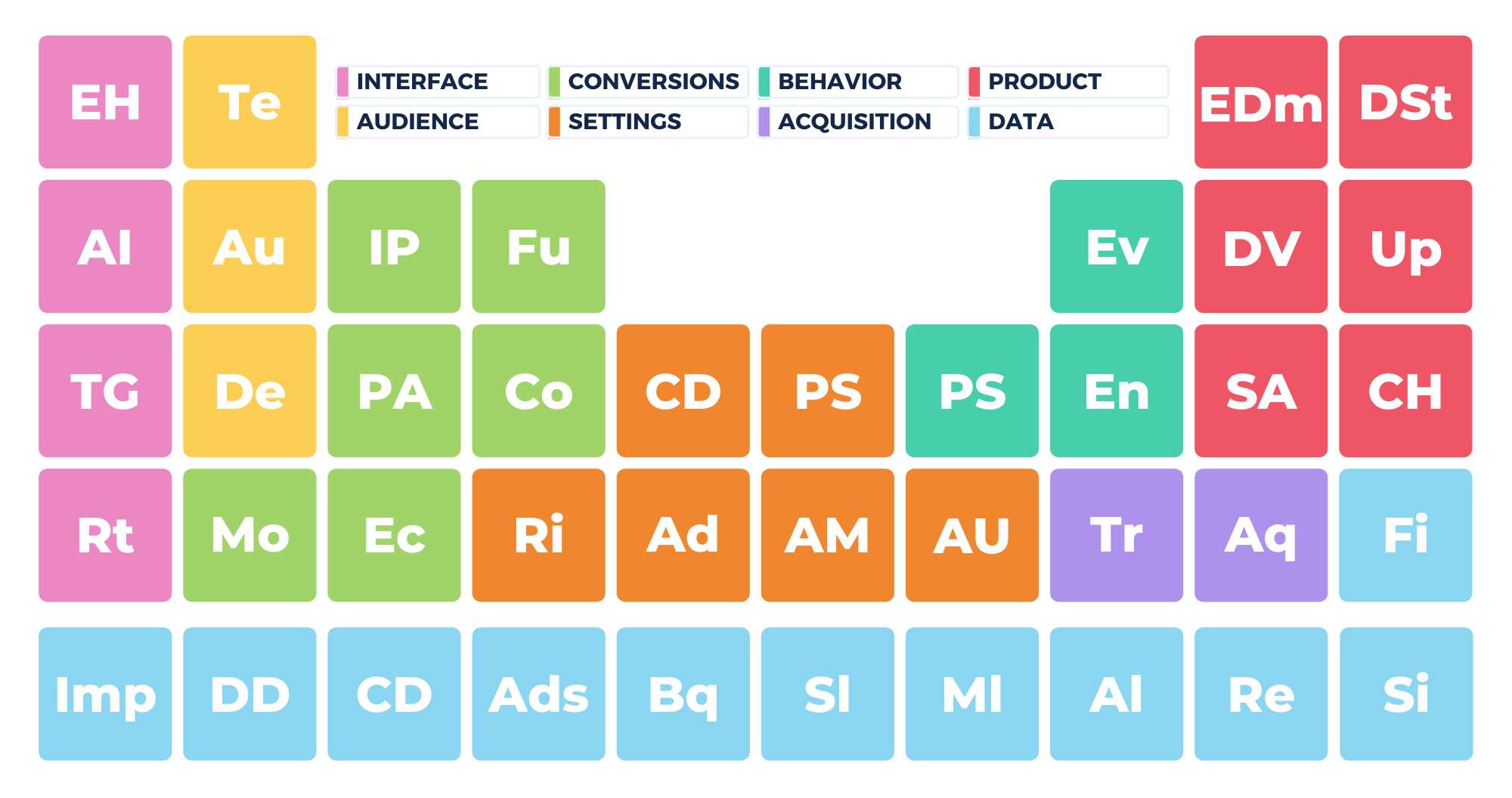
AUDIENCES
Create groups of similar website visitors into audiences for deep analysis (replaces advanced segments)

Your audience is everything.
They’re the ones who support you by visiting your website, mobile apps, and social media posts.
They’re the real people who are interested in your products and services or might be in the future. So, it makes a lot of sense that you’d want to understand your audience as intimately as possible and there are quite a few things that have changed in Google Analytics 4.
Google Analytics 4 has made analyzing your audience a broad experience, and you have several different attributes to choose from when setting up your custom audiences. While you’re figuring out your ideal strategy, you can use some of the pre-set templates Google Analytics has ready for you.
So come with us as we move through the world of audiences and discuss what they are, what pre-set options you have, and how to customize audiences in GA4.
What Are Audiences in Google Analytics 4?
Audiences are user groups you can customize to analyze visitor behavior based on particular attributes, changing or static. In GA4, you have pre-made audience templates that can help you get started, but if you want to get serious about audience data analysis, customizing your audiences is essential.
In Google Analytics 4, you can customize your audiences in almost any way you can imagine. Really, the sky’s the limit! When you customize a new audience, you'll see lots of options, like demographics, technology, behavior, date of first session, and more.
Once you’re inside any of those categories, you can further customize your audience segment. So, for example, say you go into the demographics section. There, you'll see options to customize based on age, gender, language, and location, just to name a few.
There's no limit to the ways you can customize your audiences, so you can get lost there for a while. However, this isn't just a shiny object and this can be a great use of your time! Familiarizing yourself with your audiences and their behavior is key to understanding your website traffic and adjusting your content and marketing campaigns accordingly.
Note that for each Google Analytics property, you have a limit of 100 audiences. You can check out your audience behavior at any time by looking at your real-time reports.
Audience Templates
GA4 is all about making things simple and one of the biggest benefits is just how much is ready to go right out of the box. With audiences, you have 3 pre-set templates to choose from:
- Demographics: Here, you can look at all kinds of helpful metrics like age, gender, and location. Note: Google Analytics expert Fred Pike points out that Google Analytics demographics can sometimes be misleading. While you may see in your reports that 45% of your visitors are male and 55% female, what you won’t see without further exploration is that a portion of your audience may be “unknown.” He advises digging into your demographics report to find out how much of your audience is “unknown” before taking the report at face value.
- Technology: Here you can see if your users are coming in from your website or mobile apps and what specific kind of technology they’re using.
- Acquisition: Using this template, you can easily see where your users come from before landing on your site.
Creating a New Audience in GA4
While the templates are great, if you want to get the most out of your Google Analytics reports, you’re going to need to create new audiences. Then, you can filter your reports to include or exclude almost anything you want. This is huge when it comes to targeted marketing and should be a critical step in setting up your GA4 property.
Setting up a new audience in GA4 is super easy, but you have a lot of decisions to make when you do it. To set up a new audience, follow these steps:
1. Head to “Audiences” under “Configure.”

2. Click “New Audience.”

3. Select your definitions:
- Create a custom audience: Define the parameters of your audience however you want.
- General: Configure “recently active viewers” or “non purchasers.”
- Templates: Select a helpful template that you can adjust easily. These are great for starting out with audiences! You can choose between demographics, technology, and acquisition and customize each one.

- Predictive: Full of exciting metrics, such as “likely 7-day purchasers.”
4. Try creating a custom audience. Click “Create a custom audience.”

5. Pick your condition scoping, like “across all sessions” or “within the same event.” Be careful here. This changes your report significantly.
6. Now, define all your other parameters. You can choose a lot of different audiences, so take your time going through the options. For example, you can select “purchase” under “events” to track people who result in a sale.
7. You can add all kinds of conditions here, like condition groups, sequences, and groups to exclude. You can also add more conditions to the same audience with the “or” button.
8. Select your duration, click your trigger on the right, and then hit “Save.”
Note: Pay attention to your audience trigger. Even though this doesn’t seem like a major thing, make sure to set up your audience trigger when you create a new audience. This will help you keep track of the growth of your audience. When you hit this, you’ll notice that you’ll get notified of an event when a new member becomes a part of this audience. You can then label this event as a conversion, so it’ll be extremely easy to keep track of.
The Benefits of Using Audiences
There are lots of reasons to use audiences to affect your reporting view in GA4. Depending on the needs of your business, you might want to track users for any number of reasons, but some of the most common are:
- Determine the efficacy of your marketing campaigns: You can select a specific audience you’ve been targeting to feed into your reports and see just how effective your efforts are.
- Define an audience segment for research: Maybe you want to tap into a specific market but you’re not sure how you’ll perform if you increase your efforts. You can set one up according to specific parameters and compare it with others to see which segment is more likely to engage.
- Study your conversions: Using audiences, you can easily set a specific event as an audience. This audience can be a conversion and can be tied to other factors to let you intimately study the behavior of users who convert on your site.
- Start a remarketing campaign: Remarketing using Google Analytics audiences is an excellent way to identify an underperforming category and focus your efforts there.
Using Audiences for Remarketing
One of the best ways to use your audience report is to discover when people are not responding to your marketing campaigns and use the information for remarketing purposes. Remarketing to an audience that is not resulting in an event you have configured is key to optimizing your audience. You know these people are interested, but for some reason, they’re not following through.
What’s great is that in GA4, you can add a sequence and then exclude a certain group to discover audience members that aren’t converting. So, you can set up a custom audience that follows a sequence, like users who view a targeted video, add a product to their cart, and then don’t make a purchase. To set up a sequence with a group exclusion, follow these steps:
1. Go to “Audiences” under “Configure.”
2. Click “New audience.”
3. Click “Create custom audience.”
4. Name your audience up top. Give it a descriptive name like “Remarking Efforts.”

5. Describe the sequence you want in the “Description” box.
6. Click “Add sequence.”
7. Click “Add a new condition.”
8. Here, you can select any conditions you like. In our example, we’ll select users who “added_to_cart” under “Events.” You’ll notice that there’s also an option to add a parameter, which you can do if you want to be more precise.

9. Click “Add step.”

10. In our case, we’ll select “Is directly followed by” from the drop-down menu.
11. Mark the check box to the right and choose a time limit. For example, we can choose one hour between adding to the cart and not resulting in a purchase.
12. Again select “Add a new condition.”
13. Here, we’ll select “begin_checkout.” This means we can next exclude users who began their checkout 1 hour after adding to the cart but didn’t end up in a purchase.

14. To exclude these users, click “Add group to exclude.”
15. You can choose to make this exclusion temporary or permanent from the drop-down menu.
16. Again, click “Add a new condition.”
17. Under “Events,” click “Purchase.”
18. Click “Save.”
Audiences in GA4
Using audiences, you can make a lot of adjustments in Google Analytics 4 that will feed into your reporting. From remarketing to studying conversions, there’s basically no limit to what you can do with your audiences report in GA4.
You can also use your audience templates as soon as you set up your GA4 property. With these templates, you can get essential metrics on your reports instantly. They’re also helpful for familiarizing yourself with the features you can use when setting up custom audiences.
How do you customize your audiences? Let us know!

